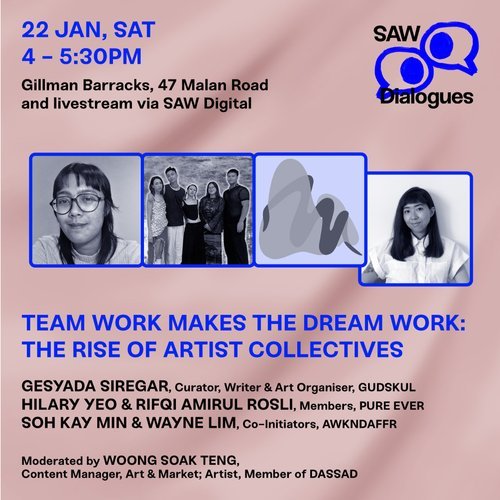SAW Dialogues 2022 | A&M Salon: Art, Food, Design
Kennie Ting, Wong Yinyin Elyn, Yen Phang, Nadya Wang
By Wan Jie Che
Screenshot of talk. From left to right: Wong Yinyin Elyn, Founder & Designer, STOLEN, Kennie Teng, Director, Asian Civilisations Museum & Peranakan Museum, Yen Phang, Artist, Nadya Wang, Editor, Art & Market.
Key points:
Cross-disciplinary projects are opportunities for learning.
Immersion in the exhibition experience is key, with less intellectual scaffolding.
Intersectional projects allow collaborators to explore niche subjects and redefine disciplines.
‘A&M Salon: Art, Food, Design’ saw an engaging discussion among Kennie Ting, Director of Asian Civilisations Museum and Peranakan Museum, and Group Director of Museums at the National Heritage Board; Wong Yinyin Elyn, Founder and Designer of STOLEN; and artist Yen Phang on the intersections that exist between art and food, and art and design, including fashion. They spoke about the cross-disciplinary projects that bridge these porous worlds.The talk was moderated by Nadya Wang, Editor of Art & Market.
Here are the takeaways:
Cross-disciplinary projects are opportunities for learning. Elyn, who is a self-taught designer, shared that the most alluring aspect about intersectional work is the uncertainty that comes with it. She appreciates the lack of boundaries or parameters in her practice as it provides eye-opening experiences and pushes her to grow as a creator.
Collaborating with different creatives and communities brings fresh perspectives and can help draw new audiences to the museum, which Kennie opines can oftentimes appear to be monolithic. ‘#SGFASHIONNOW’, a collaborative exhibition by the Asian Civilisations Museum, LASALLE College of the Arts’ School of Fashion and the Textile and Fashion Federation (TaFF) Singapore attracted a younger crowd than ACM’s usual demographic. He surmised that collaborations can help the museum appear more relevant.
Despite the uncertainty that intersectional work can bring, Yen added that collaborations opens up opportunities to witness and learn good faith and generosity. They push him to be receptive to ideas different from his own, and to be open to the sharing of knowledge and resources.
Immersion in the exhibition experience is key, with less intellectual scaffolding. Prompted by Nadya to speak about STOLEN’s ‘Zhiwa’ collection, which featured a multi-sensorial presentation, Elyn reminisced about her trip to Bhutan that inspired the collection, which was based on the quietness of the country that heightened her awareness of her surroundings. She hired a scent maker to concoct a scent representative of Bhutan, a Bhutanese singer residing in Singapore to sing traditional songs, and even engaged a Bhutanese chef who brought in local fresh ingredients to recreate the tastes and smells she had experienced.
Nadya broadened the scope of discussion to ask if immersion is intrinsically linked to working in intersections. Immersion in multi-sensorial experiences can be appealing as humans tend to be multi-sensual creatures yet based on Kennie’s experience at ACM, he finds that local museum-goers instinctively seek texts. A case in point is the constant feedback of insufficient wall text. Nadya responded that perhaps visitors tend to feel uneasy when left to their own interpretations. She then directed the discussion to Yen, who co-curated ‘Hawker! Hawker!’ at Lau Pa Sat with Oh Yam Chew for Singapore Art Week, who reflected that the local audience tends to put a premium on wall texts as they feel the need to understand context before being able to fully appreciate the experience. He pondered if there were alternative methods to prime audiences to be equanimous about the unknown and challenged programmers to change the rules of engagement and experience. This was a point that resonated with Kennie.
Intersectional projects allow collaborators to explore niche subjects and redefine disciplines. One of Yen’s most fulfilling projects was an informal housewarming in 2018 with local artists, which taught him that intersectional work is about filling niches in the ecology of ideas and the congregation of individuals from different disciplines to share ideas and break out of their disciplines. Nadya noted that such cross-disciplinary projects invite an element of playfulness that can create interesting outcomes.
Port cities, which are Kennie’s academic interests, have, historically and in contemporary contexts, been seen as the centre of intersections and innovations. As such, he sees potential for Singapore to be a hub for interdisciplinary projects. Elyn added that Singapore is an ideal geographical location for these natural hybridities to occur. While some have felt that the blending of Eastern and Western cultures in Singapore has resulted in a lack of identity, Elyn is optimistic that it can instead spark new modes of thinking. Rounding off the discussion, Nadya summarised that curiosity and friendship underpins the panellists’ collaborative practises and thanked them for the lively discussion.
Watch the full recording of ‘SAW Dialogues 2022 | A&M Salon: Art, Food, Design’ here:
You can also listen to it as a podcast here:
About the writer:
Wan Jie Che is a contributor based in Singapore with a background in Economics and Art History. She is currently working in the financial sector and has interests in cultural economics, the art market, sustainability and innovation in organisations. In her spare time, she also volunteers at a local community arts space with programming, strategy and management.















